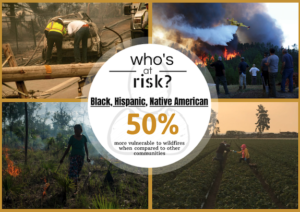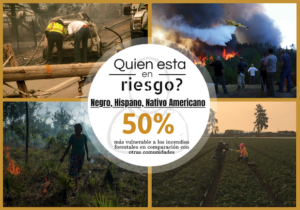By Juana Navarro, UC Merced, CECS Summer 2020 Intern
Who suffers the most from the catastrophic fires? Is it specific industries or individual communities? With the dramatic headlines that the 2017 fires in northern California generated, it was presumed that the famous wine industry would suffer greatly. But realistically, fewer than 20 of the 900 or so wineries in the Napa and Sonoma counties suffered significant damage, in fact, Napa Valley in 2018 had an 8.9% increase in tourism and was even able to expand its economyi.
So who was the real victim of these fires? Evidence shows that while larger industries become more resilient to these recurring fires, it’s minority communities that are left at a loss. In fact, minority communities such as Black, Hispanic, and Native Americans experience a 50% greater vulnerability to fires when compared to other communities. Native Americans, specifically those living on reservation land, were six times more likely to live in areas facing both fire and recovery risksii. And while Latinos make up 71% of the workforce at vineyards and other agricultural businesses and more than 40% of the workforce in the tourism and hospitality industry, many were displaced by the fires while others did not qualify for federal support due to their immigration status, leaving them without a home or a jobiii.
What factors make these communities especially vulnerable to the fires? Studies have shown that there are specific characteristics that make people particularly vulnerable to these fires, including socioeconomic status, location, language, housing, transportation, and demographicsiv.

Language plays a significant role in an individual’s vulnerability fires. In 2017, as fires raged through Napa County, most, if not all emergency messages were delivered in English even though 30% of the county is Hispanic. There was only one radio station updating information in Spanish for the thousands of Napa and Sonoma residents that were displaced by the firesv. Thus showing that at the institutional level there is a general lack of funding, and limited knowledge and limited collaborations with these diverse communities.
Minority communities are not only more vulnerable to fire but also less likely to recover quickly. When affected, these communities find it more difficult to access specialized Disaster Relief Services, due to a lack of familiarity with available resources, not having access to translated materials or interpreter services, and an overall mistrust in government related to fear of discrimination or deportation.
Beyond inadequate access to relief services, there are also long-lasting health issues that affect racial minority groups disproportionately. Asthma and respiratory infections are strongly correlated to fire smoke. Psychological issues such as trauma, PTSD, anxiety, or overall avoidance will also shadow individuals impacted by the fires. Furthermore, studies have explained that minority groups are less likely to have adequate health insurance or access to health providers and are often treated and prescribed differently by their providersvi,vii.

So how do we help these communities? Firstly, we should start by reducing health impacts during and after fires. This includes treating symptoms, having more health specialists available in these communities, and having long-term health care. Secondly, it’s important to start engaging with these diverse communities and including them when planning for emergencies. Along with that, it’s important to start providing evacuation notices in multiple languages and information on the science of climate change, its impacts, and the strategies to address it. Finally, it’s important to implement and fund technology solutions that improve fire/smoke monitoring in these at-risk communities and invest in fire prevention techniques. The Center for Ecosystem Climate Solutions is currently developing cutting edge fire and fuel models that will turn into easy to use tools to predict fire probability and severity. Through these solutions, and the added support of local policies and programs that will not only invest in these communities but will require that these risk management strategies are thoroughly implemented, and followed, we will be well into addressing the inequities that put these communities in harm’s way.
Sources:
i https://napavalleyregister.com/community/star/news/napa-valley-register-tells-stories-of-deadly-wildfires-in-october-2017/article_934ac3de-0bd6-5263-aad9-deff2da25d65.html
ii https://www.azcentral.com/story/news/local/arizona/2018/11/21/extreme-wildfires-may-hit-vulnerable-people-hardest-study-suggests/2065682002/
iii https://latinocf.org/norcal-wildfire-relief-fund/
iv https://journals.plos.org/plosone/article?id=10.1371/journal.pone.0205825
v https://www.pri.org/stories/2017-10-13/many-latinos-are-impacted-california-wildfires-spanish-language-emergency
vi https://www.cecsb.org/wp-content/uploads/2019/11/Health-Wildfires-and-Climate-Change-in-California_October-2019.pdf
vii https://www.ncbi.nlm.nih.gov/books/NBK24693/
This content was developed as part of the CECS Summer 2020 Science Communication Internship.

